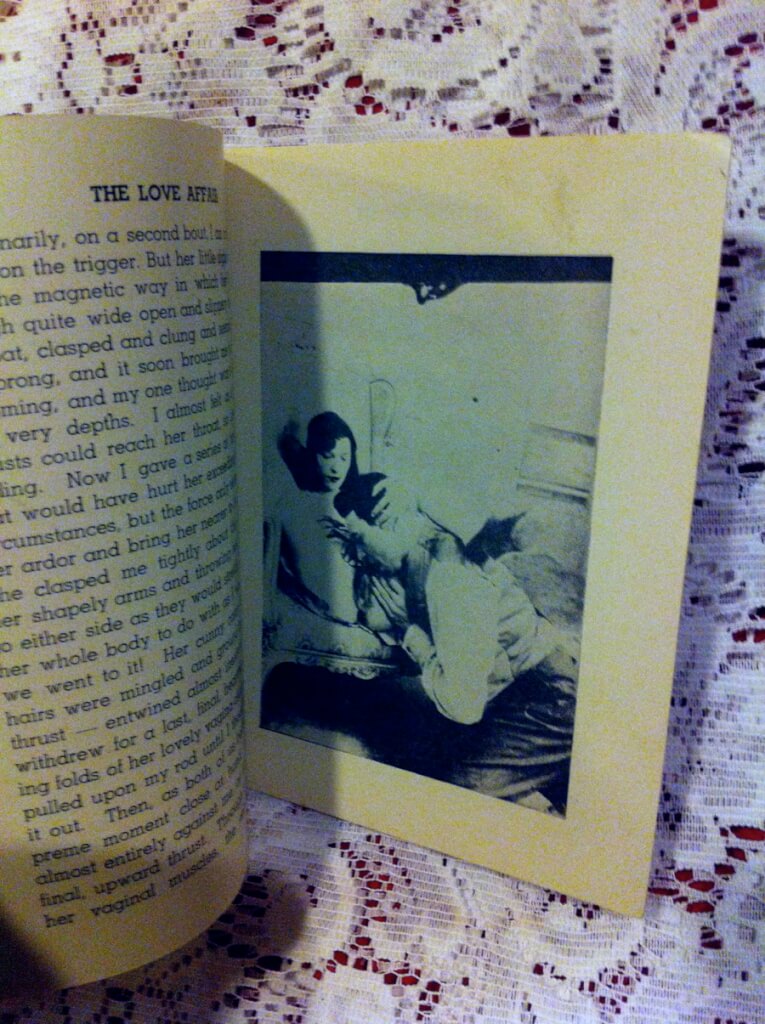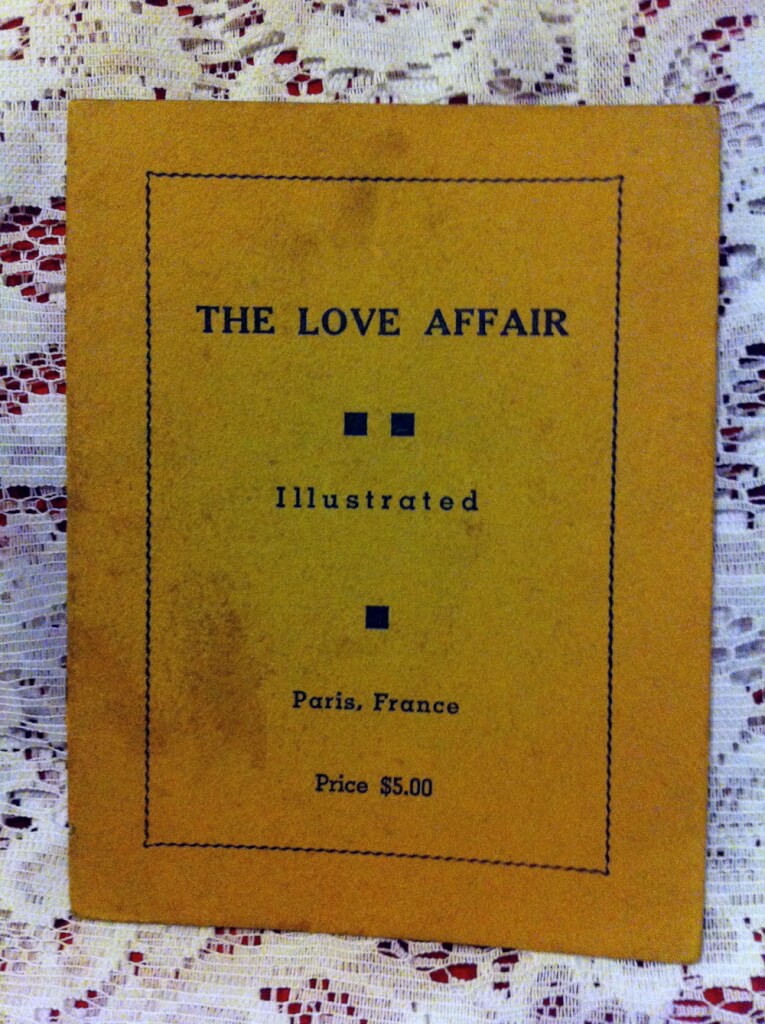-
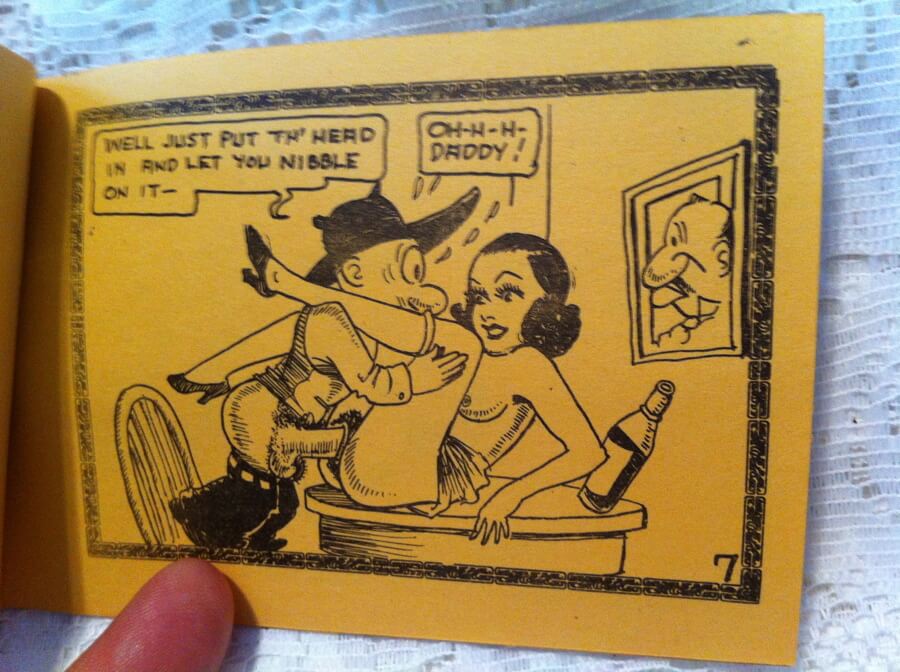
 The Great Big Man from South, Staring Barney Google, (n.p. n.d.) 4.5" x 3", 8pp. pamphlet, stapled Tijuana bibles (also known as eight-pagers, bluesies, gray-backs, Jiggs-and-Maggie books, jo-jo books, Tillie-and-Mac books, and two-by-fours) were little pornographic comic books produced in the United States from the 1920s to the early 1960s. This parodies "Barney Google and Snuffy Smith" an widely read (even today) comic strip that has been around since 1919. This booklet features an unrelated erotic illustration on the back.
The Great Big Man from South, Staring Barney Google, (n.p. n.d.) 4.5" x 3", 8pp. pamphlet, stapled Tijuana bibles (also known as eight-pagers, bluesies, gray-backs, Jiggs-and-Maggie books, jo-jo books, Tillie-and-Mac books, and two-by-fours) were little pornographic comic books produced in the United States from the 1920s to the early 1960s. This parodies "Barney Google and Snuffy Smith" an widely read (even today) comic strip that has been around since 1919. This booklet features an unrelated erotic illustration on the back. -
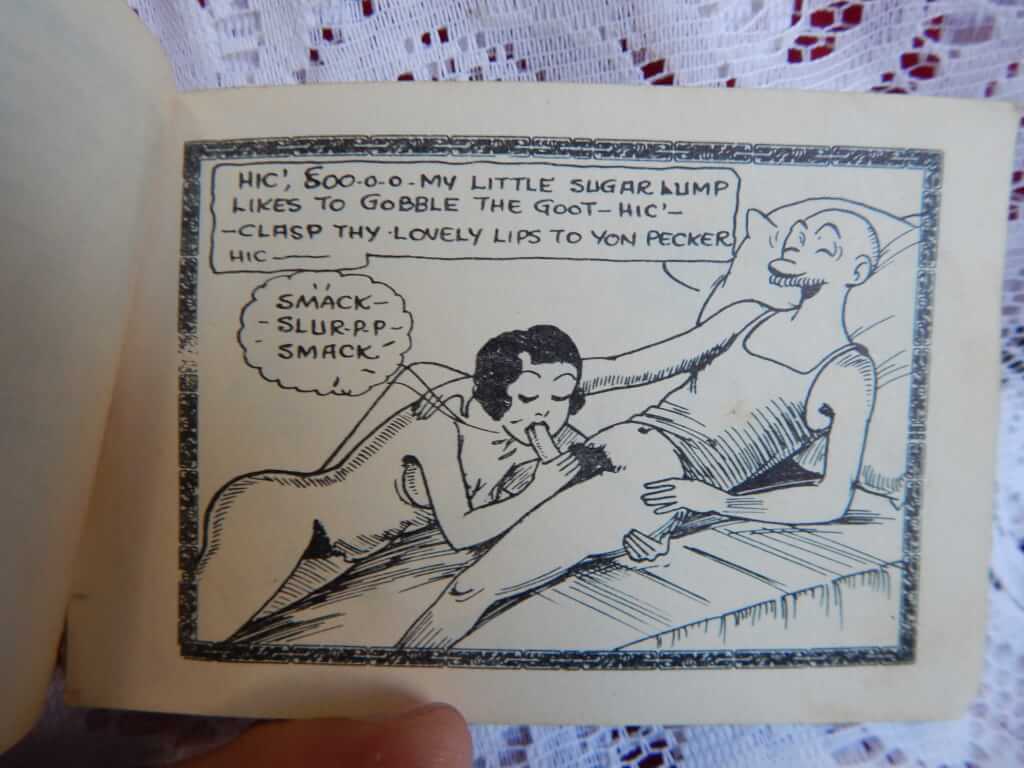
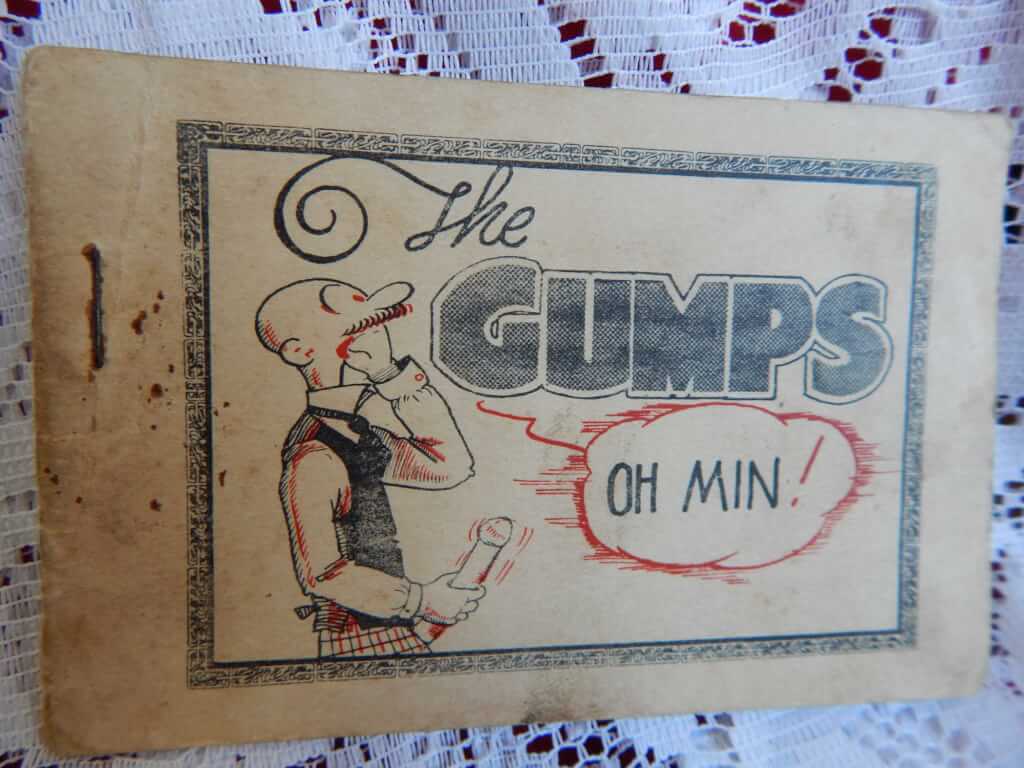 The Gumps - Oh Min!, (np. nd.) 4.5" x 3", 8pp. pamphlet, stapled Tijuana bibles (also known as eight-pagers, bluesies, gray-backs, Jiggs-and-Maggie books, jo-jo books, Tillie-and-Mac books, and two-by-fours) were little pornographic comic books produced in the United States from the 1920s to the early 1960s.
The Gumps - Oh Min!, (np. nd.) 4.5" x 3", 8pp. pamphlet, stapled Tijuana bibles (also known as eight-pagers, bluesies, gray-backs, Jiggs-and-Maggie books, jo-jo books, Tillie-and-Mac books, and two-by-fours) were little pornographic comic books produced in the United States from the 1920s to the early 1960s. -
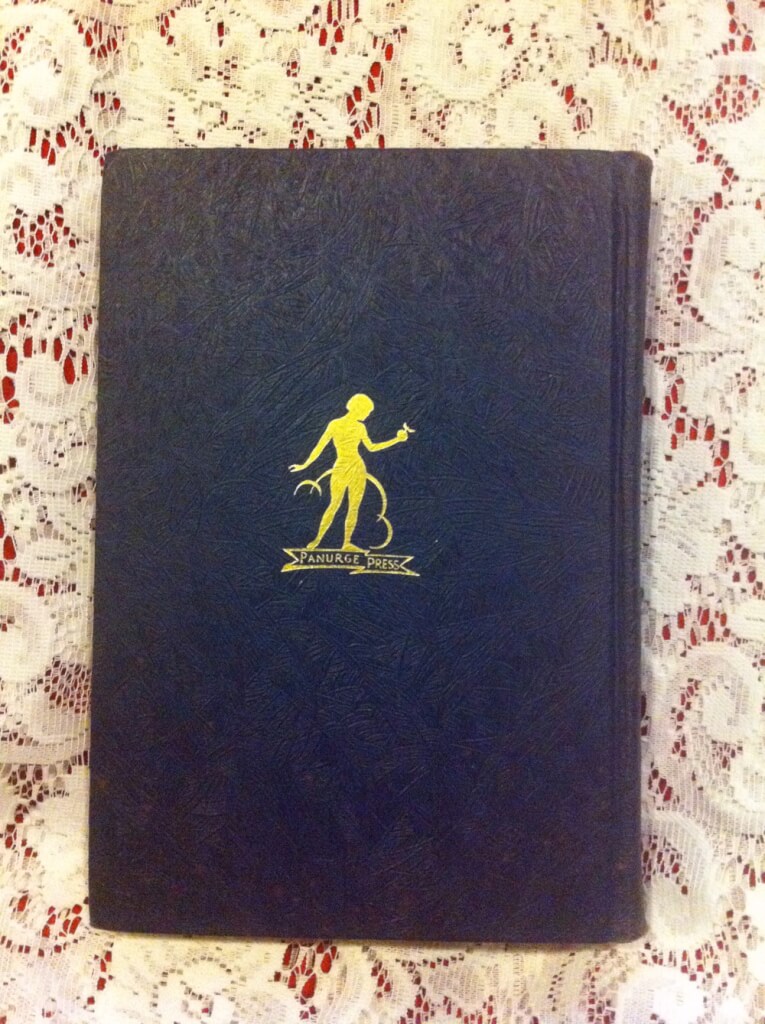
 The Heptameron, of Margaret, Queen of Navarre, Margaret of Navarre, Léopold Flameng illus. (Printed by Private Subscription and for private circulation only, np. nd. London, #61/500) 6.25″ X 7.5″, xxix-384pp, three-quarter bound over marbled boards, gilt title & decorations including boarder of leather, 8 etchings by Flameng The Heptameron is a collection of 72 short stories written in French by Marguerite of Navarre (1492-1549), published posthumously in 1558. It has the form of a frame narrative and was inspired by The Decameron of Giovanni Boccaccio. It was originally intended to contain one hundred stories covering ten days just as The Decameron does, but at Marguerite’s death it was only completed as far as the second story of the eighth day. Many of the stories deal with love, lust, infidelity, and other romantic and sexual matters. I do not know publisher or date to this edition, although it is very similar to the 1881 G. Barrie edition (page numbers and the Flemeng plates, and the Edition De Luxe label). Either it is a later pirate of that edition or an alternate printing from that batch.
The Heptameron, of Margaret, Queen of Navarre, Margaret of Navarre, Léopold Flameng illus. (Printed by Private Subscription and for private circulation only, np. nd. London, #61/500) 6.25″ X 7.5″, xxix-384pp, three-quarter bound over marbled boards, gilt title & decorations including boarder of leather, 8 etchings by Flameng The Heptameron is a collection of 72 short stories written in French by Marguerite of Navarre (1492-1549), published posthumously in 1558. It has the form of a frame narrative and was inspired by The Decameron of Giovanni Boccaccio. It was originally intended to contain one hundred stories covering ten days just as The Decameron does, but at Marguerite’s death it was only completed as far as the second story of the eighth day. Many of the stories deal with love, lust, infidelity, and other romantic and sexual matters. I do not know publisher or date to this edition, although it is very similar to the 1881 G. Barrie edition (page numbers and the Flemeng plates, and the Edition De Luxe label). Either it is a later pirate of that edition or an alternate printing from that batch. -
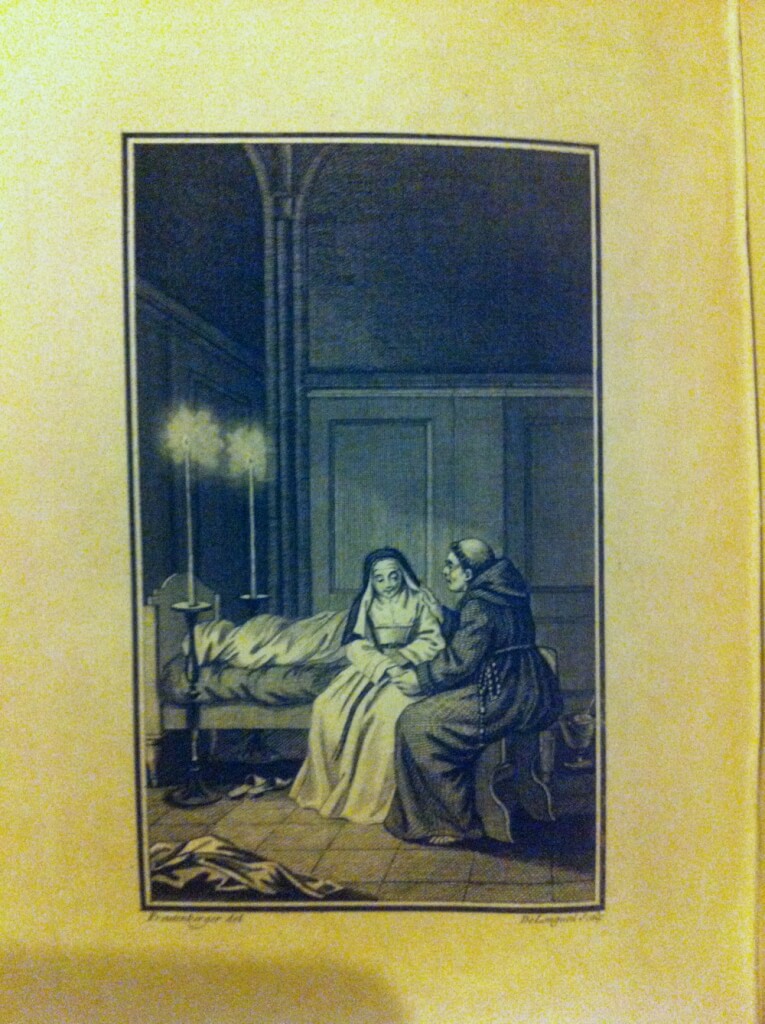
 The Heptameron, of the Tales of Margaret, Queen of Navarre, Margaret of Navarre, illustrated by S Freudenberg & Dunker, "translated into English from the Authentic Text of M. Le Roux De Lincy", essay by George Saintsbury, M.A. (The Society of English Bibliophilists, London, 1894) 8.5" X 5.25", 5 volumes 262pp, 226pp, 216pp, 244p, 264pp, blue linen covered boards with gilt titles, red and gilt decorations on covers, edges deckled. Good condition, minor bumps and scuffs. The Heptameron is a collection of 72 short stories written in French by Marguerite of Navarre (1492-1549), published posthumously in 1558. It has the form of a frame narrative and was inspired by The Decameron of Giovanni Boccaccio. It was originally intended to contain one hundred stories covering ten days just as The Decameron does, but at Marguerite's death it was only completed as far as the second story of the eighth day. Many of the stories deal with love, lust, infidelity and other romantic and sexual matters. This 5 volume set is very nice edition containing "the Original Seventy-three Full Page Engravings Designed by S. FREUDENBERG And One Hundred and Fifty Head and Tail Pieces By DUNKER"
The Heptameron, of the Tales of Margaret, Queen of Navarre, Margaret of Navarre, illustrated by S Freudenberg & Dunker, "translated into English from the Authentic Text of M. Le Roux De Lincy", essay by George Saintsbury, M.A. (The Society of English Bibliophilists, London, 1894) 8.5" X 5.25", 5 volumes 262pp, 226pp, 216pp, 244p, 264pp, blue linen covered boards with gilt titles, red and gilt decorations on covers, edges deckled. Good condition, minor bumps and scuffs. The Heptameron is a collection of 72 short stories written in French by Marguerite of Navarre (1492-1549), published posthumously in 1558. It has the form of a frame narrative and was inspired by The Decameron of Giovanni Boccaccio. It was originally intended to contain one hundred stories covering ten days just as The Decameron does, but at Marguerite's death it was only completed as far as the second story of the eighth day. Many of the stories deal with love, lust, infidelity and other romantic and sexual matters. This 5 volume set is very nice edition containing "the Original Seventy-three Full Page Engravings Designed by S. FREUDENBERG And One Hundred and Fifty Head and Tail Pieces By DUNKER" -
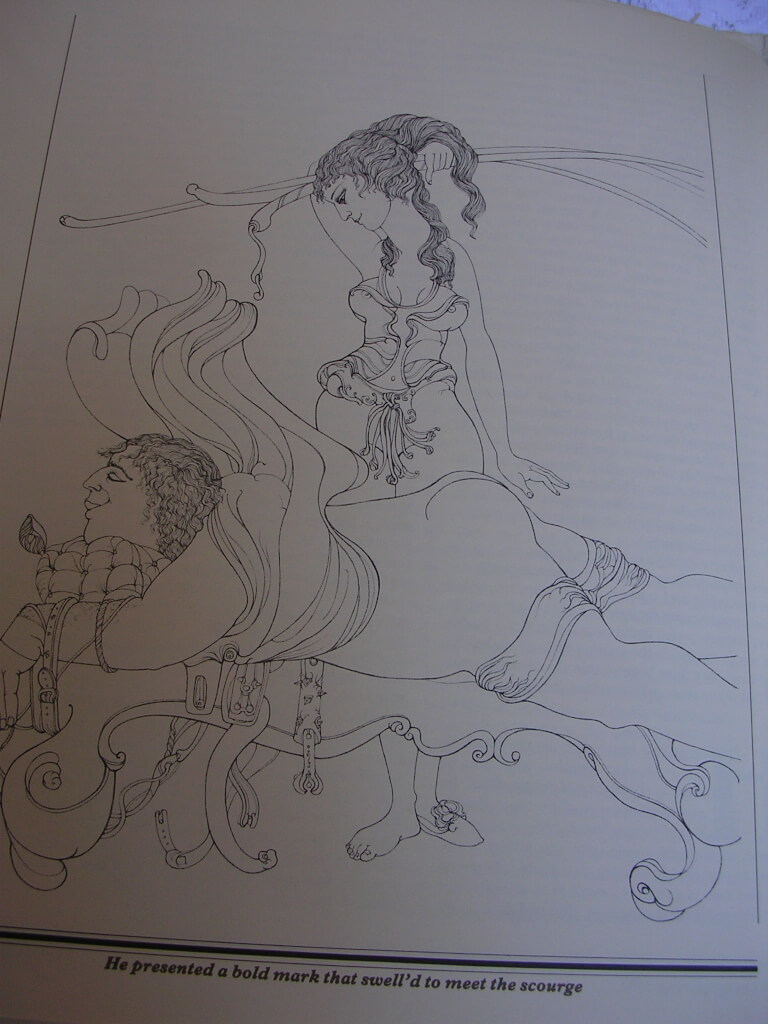
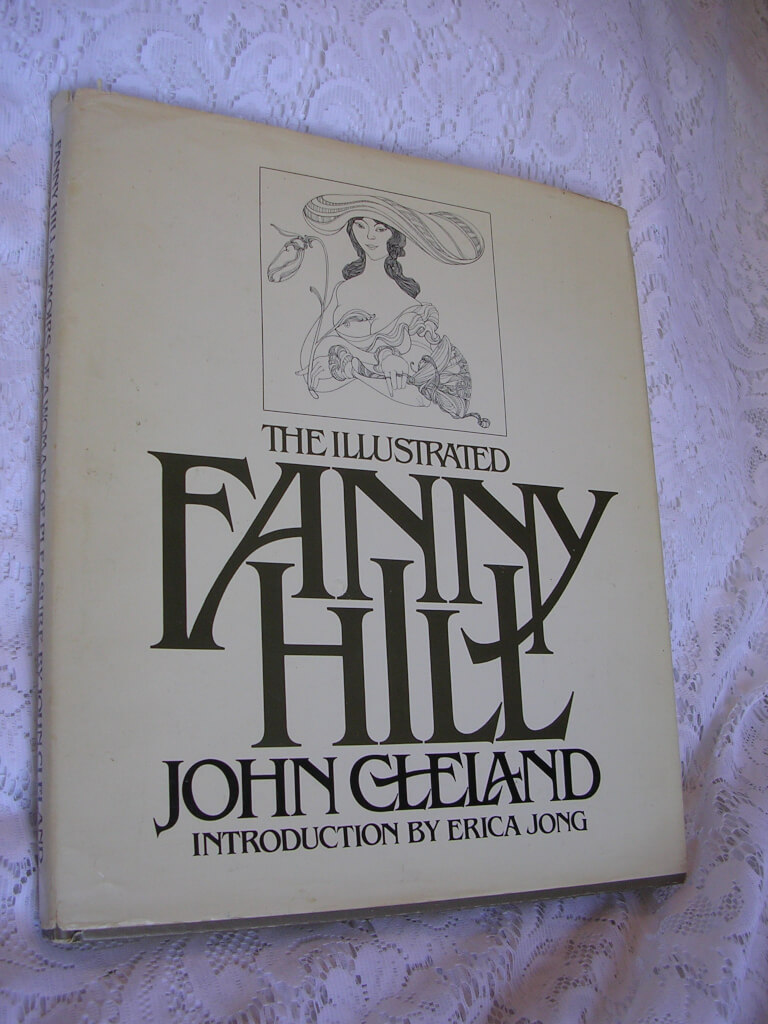 The Illustrated Fanny Hill, John Cleland, illustrated by Zevi Blum, introduction written by Erica Jong, designed by Herb Lubalin (The Erotic Artbook Society [Ralph Ginzburg], 1978, first edition thus, stated "NE PLUS EDITION") 12.5" X 10.5", 127pp, hardbound with DJ, very good condition, minor tears to dust jacket Written while the author was in debtor's prison in London and first published in 1748, Fanny Hill is considered the first original English prose pornography, and the first pornography to use the form of the novel. One of the most prosecuted and banned books in history, it has become a synonym for obscenity. Dust Jacket shows some wear but in good condition. This copy is an excellent and beautiful "legal" (meaning post-1966 Supreme Court Case) edition of Fanny Hill. It was published by Ralph Ginzburg (Eros Magazine, Fact Magazine, served 8 months of a 5 year prison term for obscenity). The illustrations are beautifully done and have a psychedelic feel to them.
The Illustrated Fanny Hill, John Cleland, illustrated by Zevi Blum, introduction written by Erica Jong, designed by Herb Lubalin (The Erotic Artbook Society [Ralph Ginzburg], 1978, first edition thus, stated "NE PLUS EDITION") 12.5" X 10.5", 127pp, hardbound with DJ, very good condition, minor tears to dust jacket Written while the author was in debtor's prison in London and first published in 1748, Fanny Hill is considered the first original English prose pornography, and the first pornography to use the form of the novel. One of the most prosecuted and banned books in history, it has become a synonym for obscenity. Dust Jacket shows some wear but in good condition. This copy is an excellent and beautiful "legal" (meaning post-1966 Supreme Court Case) edition of Fanny Hill. It was published by Ralph Ginzburg (Eros Magazine, Fact Magazine, served 8 months of a 5 year prison term for obscenity). The illustrations are beautifully done and have a psychedelic feel to them. -
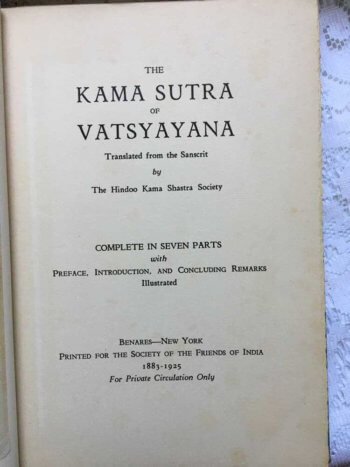
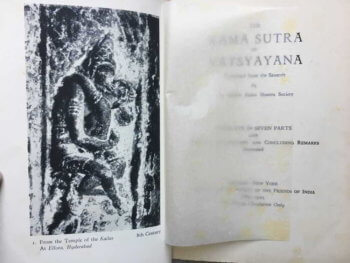 <strong>The Kama Sutra of Vatsyayana | Translated from the Sanscrit by The Hindoo Kama Shastra Society | Complete in seven parts with Preface, Introduction, and Concluding Remarks | Illustrated</strong>, by Vatsyayana (Printed for the Society of the Friends of India 1883-1925, Benares-New York, one of 800, unnumbered) <em>6"x9", xxi+175pp, hardbound, blue boards, hand laid paper, top-edge gilt, others deckled, 8 B/W half-tone reproductions of erotic Hindu stone-sculptures with tissue guards, soiling on boards, inner pages are clean, binding is good.</em> Attributed to ancient Indian philosopher Vatsyayana, the Kama Sutra is generally believed to have been composed between 400 and 200 B.C.E. Although a portion of the work consists of practical advice on sexual intercourse, the work is primarily prose consisting of 1250 verses distributed over 36 chapters structured into seven parts. This book lists those parts as: Part I. Index, and General Consideration of the Subject Part II. Of Sexual Union Part III. About the Acquisition of a Wife Part IV. About a Wife Part V. About the Wives of Other People Part VI. About Courtezans Part VII. On the Means of Attracting Others to Oneself
<strong>The Kama Sutra of Vatsyayana | Translated from the Sanscrit by The Hindoo Kama Shastra Society | Complete in seven parts with Preface, Introduction, and Concluding Remarks | Illustrated</strong>, by Vatsyayana (Printed for the Society of the Friends of India 1883-1925, Benares-New York, one of 800, unnumbered) <em>6"x9", xxi+175pp, hardbound, blue boards, hand laid paper, top-edge gilt, others deckled, 8 B/W half-tone reproductions of erotic Hindu stone-sculptures with tissue guards, soiling on boards, inner pages are clean, binding is good.</em> Attributed to ancient Indian philosopher Vatsyayana, the Kama Sutra is generally believed to have been composed between 400 and 200 B.C.E. Although a portion of the work consists of practical advice on sexual intercourse, the work is primarily prose consisting of 1250 verses distributed over 36 chapters structured into seven parts. This book lists those parts as: Part I. Index, and General Consideration of the Subject Part II. Of Sexual Union Part III. About the Acquisition of a Wife Part IV. About a Wife Part V. About the Wives of Other People Part VI. About Courtezans Part VII. On the Means of Attracting Others to Oneself -
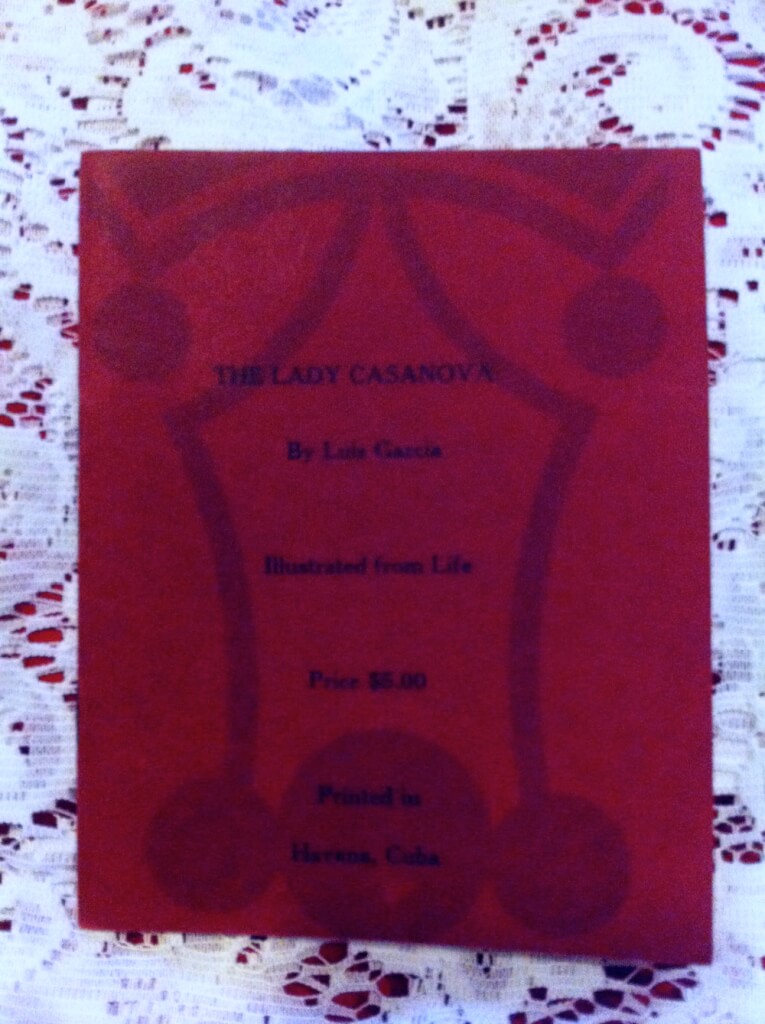 The Lady Cassanova, Luis Garcia (Printed in Havana, Cuba, np, nd) 5.5" X 4.25", 32pp, softcover, good quality for age, very pornographic photos, stated "Illustrated from Life" vintage underground erotic pamphlet illustrated with vintage pornographic photos (these were illegal when printed so no publisher, no date, if listed it is probably false)
The Lady Cassanova, Luis Garcia (Printed in Havana, Cuba, np, nd) 5.5" X 4.25", 32pp, softcover, good quality for age, very pornographic photos, stated "Illustrated from Life" vintage underground erotic pamphlet illustrated with vintage pornographic photos (these were illegal when printed so no publisher, no date, if listed it is probably false) -
 The Life and Adventures of Father Silas | written by himself and now first translated from the original French edition (dated 1742), anonymous [attributed to Jean-Charles Gervaise de Latouche], (np [Charles Hirsch?], London, 1907) 7" X 4.5", 185pp, beautifully bound full red morocco with gilt border on boards, gilt decorations and title on spine, 5 raised bands, deckled edges, illustrations not present, good+ condition, slight internal foxing, a beautiful copy of a rare book. Originally published in French, Histoire de Dom Bougre, Portier des Chartreux is a French novel from 1741. Allegedly the anonymous author was Jean-Charles Gervaise de Latouche. Histoire de Dom Bougre is one of the most celebrated French erotic novels of the 18th century, and one of the most frequently reprinted. The novel was published under a variety of titles in French: Histoire de Dom B... (1741), Histoire de Gouberdom (1772), Mémoires de Saturnin (1787), Le Portier des chartreux (1784) and Histoire de Saturnin (1908). Translations into English have appeared under a similar variety of titles, such as The History of Don [sic] B. (1743), The Life and Adventures of Silas Shovewell (1801) and The History of Father Saturnin alias Don B*** alias Gouberdom – Porter of the Charterhouse at Paris (ca. 1827). The novel tells from the first-person perspective the life story of the monk B... (the acronym stands for Bougre, a French vulgar expression for pederast), whose real name is Saturnin. Saturnin's first sexual intercourse is with his sister Suzon and his mother. Even if it turns out later that in reality there is no blood relationship, the text heralds an incessant series of taboo breaking with this alleged incest. In the further course of numerous humorously designed scenes, Saturnin will experience all varieties of sexual disinhibition, whereby ruthless criticism of church and society is also practiced in constant alternation. Finally, Saturnin meets the syphilis sister in a brothel. He loves her sincerely and spends the night with her, although she warns him about the risk of infection. The two are torn apart the next day; Saturnin falls ill and is forcibly castrated to save his life, Suzon dies. In the end, Saturnin finds refuge in a Carthusian monastery, where, freed from all passions, he can await death, which he neither fears nor longs for. He would like the words: Hic situs est Dom Bougre, fututus, futuit (Here lies Dom Bougre, he fucked, and was fucked), to be inscribed on his grave. Jean-Charles Gervaise de Latouche (1715 - 1782), was a French writer. He was a lawyer at the Parlement de Paris of the Ancien Régime. The authorship of the licentious books Mémoires de Mademoiselle de Bonneval (1738), Histoire de Dom Bougre, Portier des Chartreux (1741), and possibly also Lyndamine, ou, L'optimisme des pays chauds (1778) has been attributed to him. Charles Hirsch was a French bookseller in Victorian London who sold French literature and ran a clandestine trade in expensive pornography. Hirsch's bookshop Librairie Parisienne was at Coventry Street, London. He also published in Paris and translated pornographic works from French to English and vice versa. Hirsch knew Oscar Wilde, and claimed to have sold him various works of erotica, including The Sins of the Cities of the Plain in 1890. Hirsch describes how Wilde brought the manuscript of Teleny to his bookshop in 1890 instructing that it be held until a friend, who would be carrying Wilde's card, came to retrieve it. "A few days later one of the young gentlemen I had seen with [Wilde] came to collect the package. He kept it for a while and then brought it back saying in turn: 'Would you kindly give this to one of our friends who will come to fetch it in the same person's name'". Hirsch recounts three further repetitions of this "identical ceremony" before the package made its way back to Wilde. Hirsch defied the strict instructions not to open the package while it was in his care, and claims that it was written in several different hands, which lends further support to his supposition that it was authored in "round robin" style by a small group of Wilde's intimate associates.
The Life and Adventures of Father Silas | written by himself and now first translated from the original French edition (dated 1742), anonymous [attributed to Jean-Charles Gervaise de Latouche], (np [Charles Hirsch?], London, 1907) 7" X 4.5", 185pp, beautifully bound full red morocco with gilt border on boards, gilt decorations and title on spine, 5 raised bands, deckled edges, illustrations not present, good+ condition, slight internal foxing, a beautiful copy of a rare book. Originally published in French, Histoire de Dom Bougre, Portier des Chartreux is a French novel from 1741. Allegedly the anonymous author was Jean-Charles Gervaise de Latouche. Histoire de Dom Bougre is one of the most celebrated French erotic novels of the 18th century, and one of the most frequently reprinted. The novel was published under a variety of titles in French: Histoire de Dom B... (1741), Histoire de Gouberdom (1772), Mémoires de Saturnin (1787), Le Portier des chartreux (1784) and Histoire de Saturnin (1908). Translations into English have appeared under a similar variety of titles, such as The History of Don [sic] B. (1743), The Life and Adventures of Silas Shovewell (1801) and The History of Father Saturnin alias Don B*** alias Gouberdom – Porter of the Charterhouse at Paris (ca. 1827). The novel tells from the first-person perspective the life story of the monk B... (the acronym stands for Bougre, a French vulgar expression for pederast), whose real name is Saturnin. Saturnin's first sexual intercourse is with his sister Suzon and his mother. Even if it turns out later that in reality there is no blood relationship, the text heralds an incessant series of taboo breaking with this alleged incest. In the further course of numerous humorously designed scenes, Saturnin will experience all varieties of sexual disinhibition, whereby ruthless criticism of church and society is also practiced in constant alternation. Finally, Saturnin meets the syphilis sister in a brothel. He loves her sincerely and spends the night with her, although she warns him about the risk of infection. The two are torn apart the next day; Saturnin falls ill and is forcibly castrated to save his life, Suzon dies. In the end, Saturnin finds refuge in a Carthusian monastery, where, freed from all passions, he can await death, which he neither fears nor longs for. He would like the words: Hic situs est Dom Bougre, fututus, futuit (Here lies Dom Bougre, he fucked, and was fucked), to be inscribed on his grave. Jean-Charles Gervaise de Latouche (1715 - 1782), was a French writer. He was a lawyer at the Parlement de Paris of the Ancien Régime. The authorship of the licentious books Mémoires de Mademoiselle de Bonneval (1738), Histoire de Dom Bougre, Portier des Chartreux (1741), and possibly also Lyndamine, ou, L'optimisme des pays chauds (1778) has been attributed to him. Charles Hirsch was a French bookseller in Victorian London who sold French literature and ran a clandestine trade in expensive pornography. Hirsch's bookshop Librairie Parisienne was at Coventry Street, London. He also published in Paris and translated pornographic works from French to English and vice versa. Hirsch knew Oscar Wilde, and claimed to have sold him various works of erotica, including The Sins of the Cities of the Plain in 1890. Hirsch describes how Wilde brought the manuscript of Teleny to his bookshop in 1890 instructing that it be held until a friend, who would be carrying Wilde's card, came to retrieve it. "A few days later one of the young gentlemen I had seen with [Wilde] came to collect the package. He kept it for a while and then brought it back saying in turn: 'Would you kindly give this to one of our friends who will come to fetch it in the same person's name'". Hirsch recounts three further repetitions of this "identical ceremony" before the package made its way back to Wilde. Hirsch defied the strict instructions not to open the package while it was in his care, and claims that it was written in several different hands, which lends further support to his supposition that it was authored in "round robin" style by a small group of Wilde's intimate associates. -
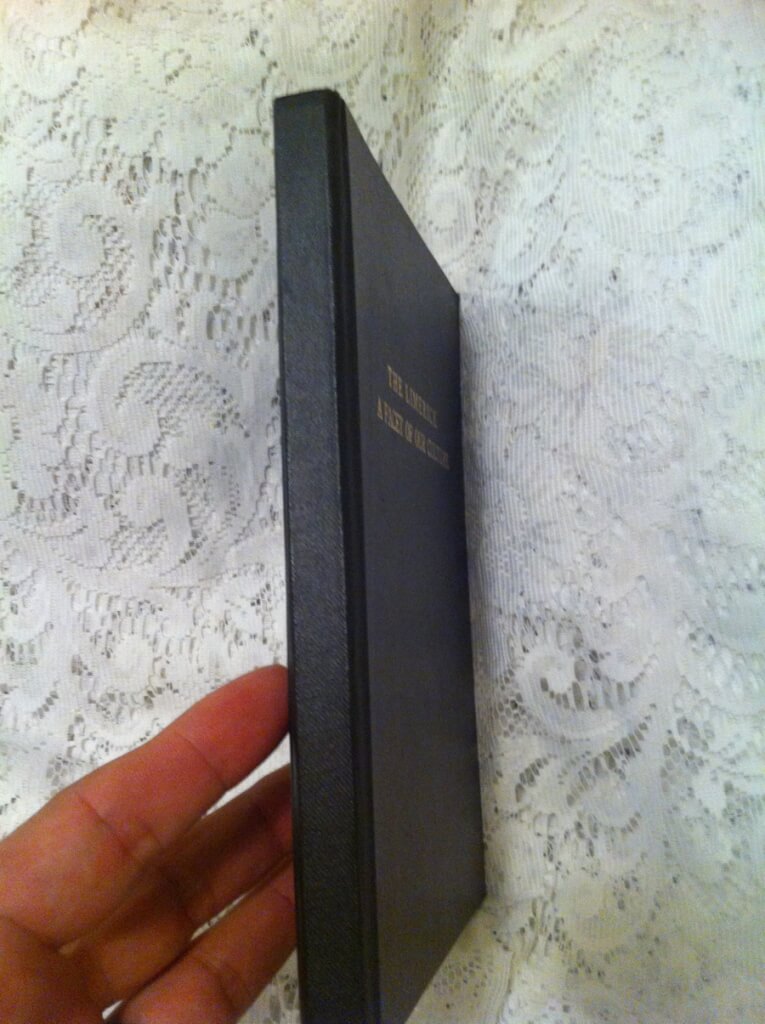
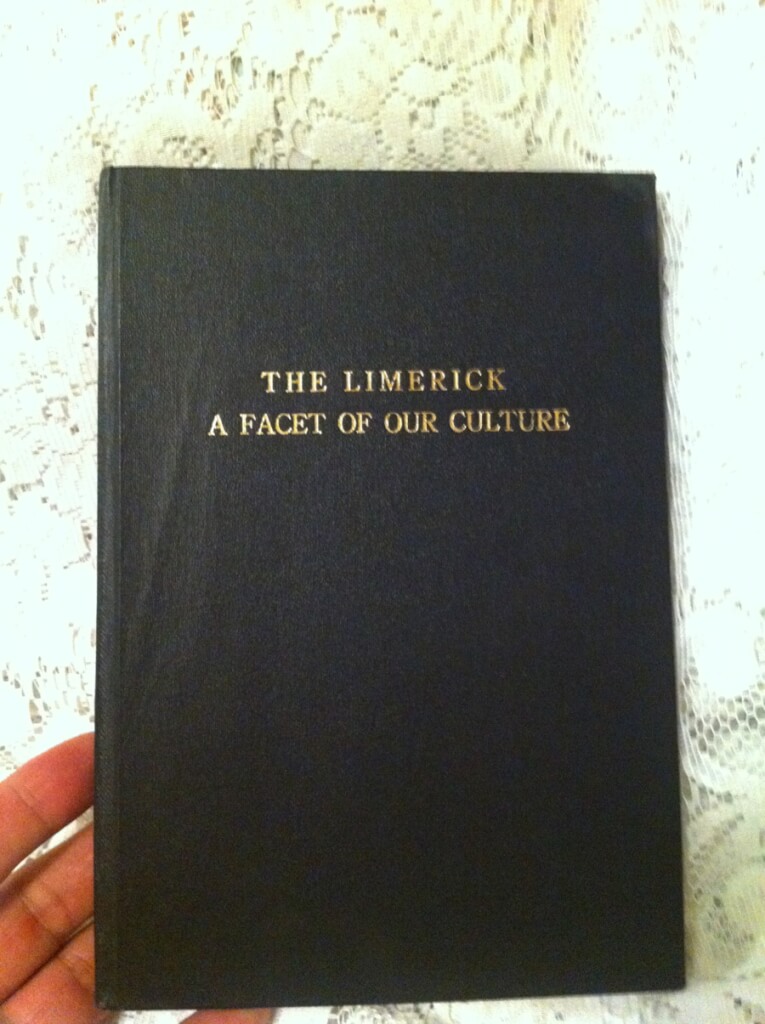 The Limerick, a facet of our culture, anonymous [A. Reynolds Morse] ( Cruciform Press, Mexico City: Privately Printed for Private Circulation to Subscribers Only, 1944 [Cleveland, Ohio: A. Reynolds Morse, 1948.] #208/250) 8" X 5.5", vii+157pp. Hardbound, black cloth boards, gilt lettering on cover. near fine condition (rare for this edition!), slight rust around staples. A. Reynolds Morse was an American, born in 1914, who died in 2000. He moved to Cleveland from Denver in 1941. An industrialist and philanthropist, he is best known for his activity in collecting works by Salvador Dali, and founding the Salvador Dali Museum. According to his obituary in the New York Times, Reynolds and his wife "embarked on a sometimes turbulent friendship with Dali and his wife, Gala". He also had a hobby of collecting and publishing works that other publishers would not print. Title page: "A study of the history and development of the limerick, ensplendor'd with over two hundred examples of the immortal verse form, commentaries, and index" This book is considered by most to be the "dirtiest" collection of limericks. Mr. Morse also published "Folk Poems and Ballads An Anthology". Both books were suppressed by police action in the late 1940's. This is a VERY rare near fine copy of this hard-to-find book. It was poorly made so most of the copies out there have signatures loose.
The Limerick, a facet of our culture, anonymous [A. Reynolds Morse] ( Cruciform Press, Mexico City: Privately Printed for Private Circulation to Subscribers Only, 1944 [Cleveland, Ohio: A. Reynolds Morse, 1948.] #208/250) 8" X 5.5", vii+157pp. Hardbound, black cloth boards, gilt lettering on cover. near fine condition (rare for this edition!), slight rust around staples. A. Reynolds Morse was an American, born in 1914, who died in 2000. He moved to Cleveland from Denver in 1941. An industrialist and philanthropist, he is best known for his activity in collecting works by Salvador Dali, and founding the Salvador Dali Museum. According to his obituary in the New York Times, Reynolds and his wife "embarked on a sometimes turbulent friendship with Dali and his wife, Gala". He also had a hobby of collecting and publishing works that other publishers would not print. Title page: "A study of the history and development of the limerick, ensplendor'd with over two hundred examples of the immortal verse form, commentaries, and index" This book is considered by most to be the "dirtiest" collection of limericks. Mr. Morse also published "Folk Poems and Ballads An Anthology". Both books were suppressed by police action in the late 1940's. This is a VERY rare near fine copy of this hard-to-find book. It was poorly made so most of the copies out there have signatures loose. -

 The Little King in Every Man for Himself, "by Fyst Phrigger" (n.p. n.d.) 4.5" x 3", 8pp. pamphlet, stapled Tijuana bibles (also known as eight-pagers, bluesies, gray-backs, Jiggs-and-Maggie books, jo-jo books, Tillie-and-Mac books, and two-by-fours) were little pornographic comic books produced in the United States from the 1920s to the early 1960s.
The Little King in Every Man for Himself, "by Fyst Phrigger" (n.p. n.d.) 4.5" x 3", 8pp. pamphlet, stapled Tijuana bibles (also known as eight-pagers, bluesies, gray-backs, Jiggs-and-Maggie books, jo-jo books, Tillie-and-Mac books, and two-by-fours) were little pornographic comic books produced in the United States from the 1920s to the early 1960s. -
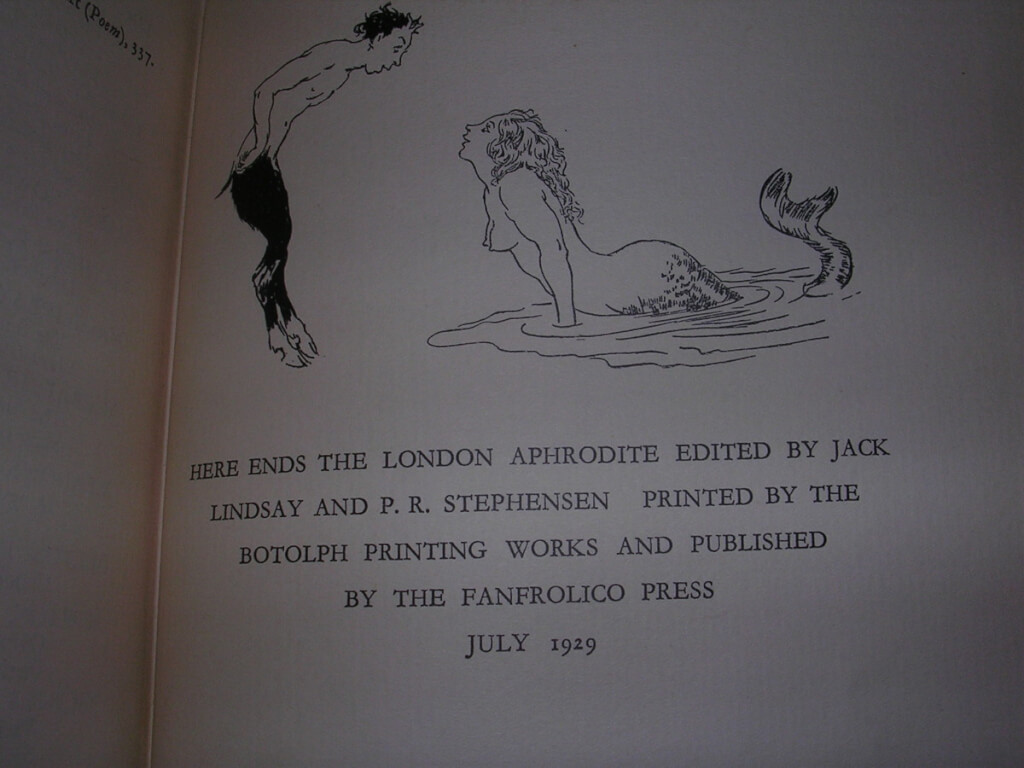
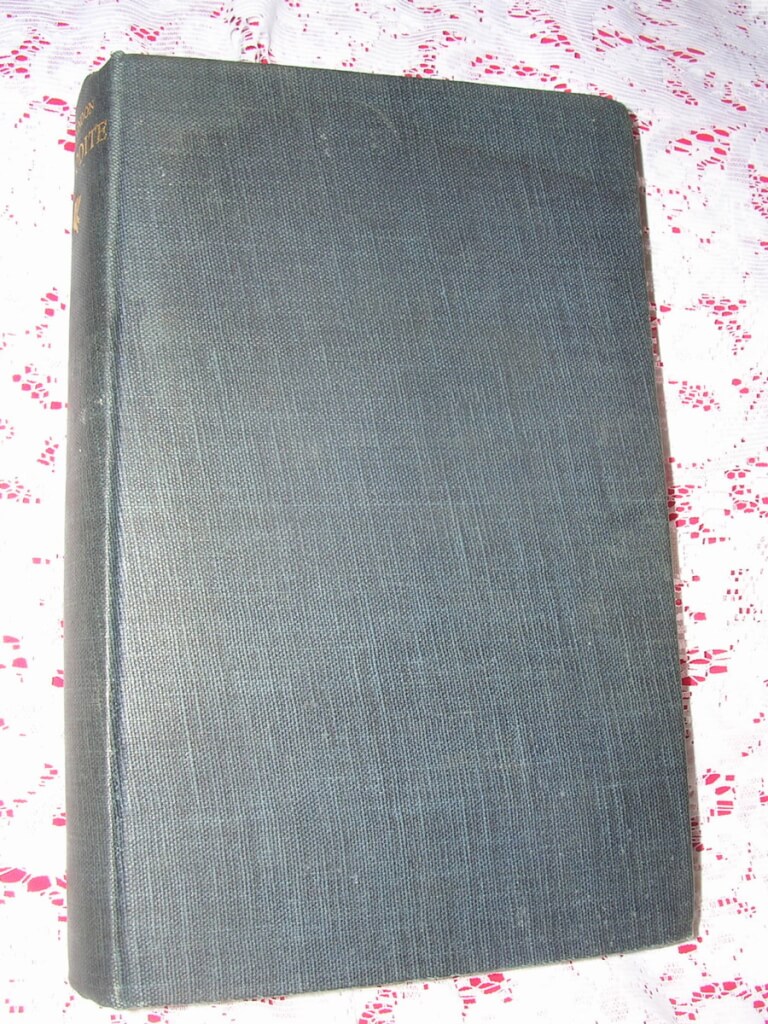 The London Aphrodite, ed. Jack Lindsay and P.R. Stephensen (Fanfrolico Press, "printed by the Botolph Printing Works", London, 1929) 9.75" X 6.24", 496pp plus index. hardcover no DJ, blue cloth boards, gilt title on spine, top edge gilt. Excellent condition. A periodical edited by Jack Lindsay and P.R. Stephensen and published in London by the Fanfrolico Press, ran for a planned six issues 1928-29. Self-described as "A Miscellany of Poems Stories and Essays by Various Hands Eminent or Rebellious." Named as a rebuttal of the conservatism of J.C. Squire's London Mercury, it was committed to the same aesthetic attitudes as Vision. Some prominent English authors, including Aldous Huxley, contributed, although the majority were Australian. Jack Lindsay, the dominant force, used the pseudonym 'Peter Meadows' for several articles. Other Australian contributors were Norman Lindsay, Hugh McCrae, Kenneth Slessor, Philip Lindsay, Brian Penton, P.R. Stephensen, Les Robinson, W.J. Turner, Bertram Higgins, E.J. Rupert Atkinson and Edith Hepburn ('Anna Wickham'). This is a compilation of those issues in book form, published by Fanfrolico Press.
The London Aphrodite, ed. Jack Lindsay and P.R. Stephensen (Fanfrolico Press, "printed by the Botolph Printing Works", London, 1929) 9.75" X 6.24", 496pp plus index. hardcover no DJ, blue cloth boards, gilt title on spine, top edge gilt. Excellent condition. A periodical edited by Jack Lindsay and P.R. Stephensen and published in London by the Fanfrolico Press, ran for a planned six issues 1928-29. Self-described as "A Miscellany of Poems Stories and Essays by Various Hands Eminent or Rebellious." Named as a rebuttal of the conservatism of J.C. Squire's London Mercury, it was committed to the same aesthetic attitudes as Vision. Some prominent English authors, including Aldous Huxley, contributed, although the majority were Australian. Jack Lindsay, the dominant force, used the pseudonym 'Peter Meadows' for several articles. Other Australian contributors were Norman Lindsay, Hugh McCrae, Kenneth Slessor, Philip Lindsay, Brian Penton, P.R. Stephensen, Les Robinson, W.J. Turner, Bertram Higgins, E.J. Rupert Atkinson and Edith Hepburn ('Anna Wickham'). This is a compilation of those issues in book form, published by Fanfrolico Press. -
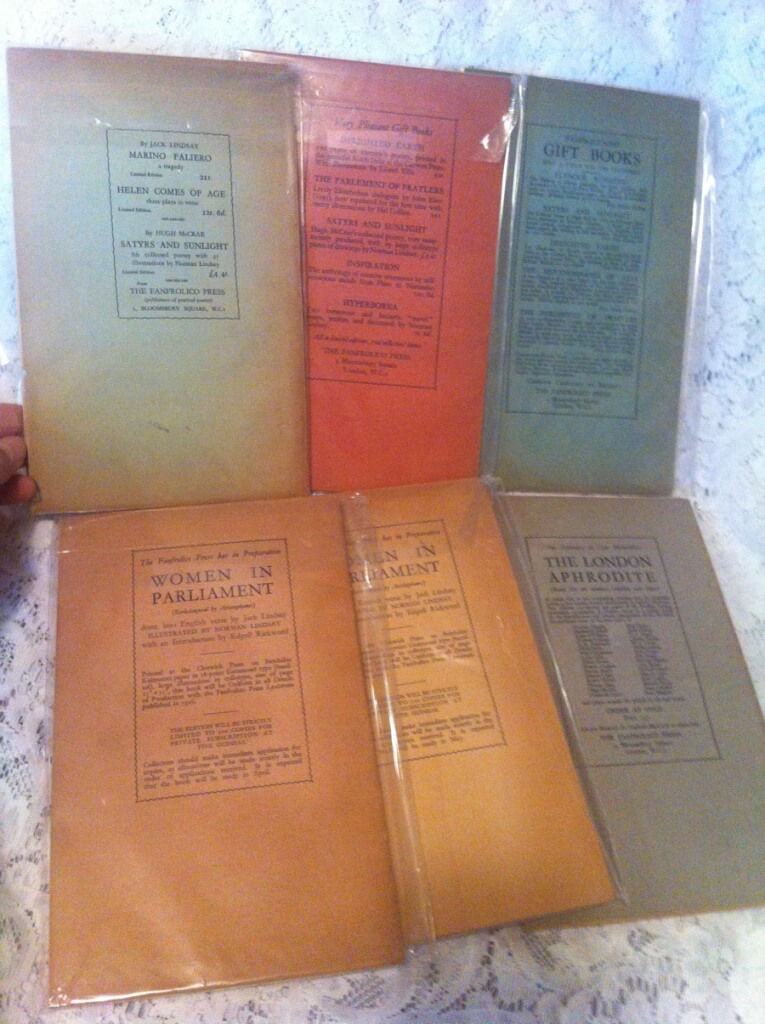
 The London Aphrodite, ed. Jack Lindsay and P.R. Stephensen (Fanfrolico Press, "printed by the Botolph Printing Works", London, 1928 - 29) 9.75" X 6.25", 496pp numbered sequentially throughout series, v1 1-64, v2 45-160, v3 161-232, v4 233-316, v5 317-400, v6 401-496, full set of 6 planned issues, great condition for age, the expected sunning/fading from soft-cover periodical of this era, small ink price stamp to front of v1. A periodical edited by Jack Lindsay and P.R. Stephensen and published in London by the Fanfrolico Press, ran bi-monthly for a planned six issues August 1928 - June 29. Self-described as "A Miscellany of Poems Stories and Essays by Various Hands Eminent or Rebellious." Named as a rebuttal of the conservatism of J.C. Squire's London Mercury, it was committed to the same aesthetic attitudes as Vision. Some prominent writers, including Aldous Huxley, Norman Lindsay, Robert Nichols, Liam O'Flaherty, Edward Marsh, Edward Marsh, Norman Douglas, Stanley Snaith, Alexander Blok, Hugh McCrae, Kenneth Slessor, Philip Lindsay, Brian Penton, P.R. Stephensen, Les Robinson, W.J. Turner, Bertram Higgins, E.J. Rupert Atkinson, Sacheverell Sitwell, T.F. Powys, Rhys Davides, and Edith Hepburn ('Anna Wickham'). Jack Lindsay, the dominant force, used the pseudonym 'Peter Meadows' for several articles. Fanfrolico Press, Australia’s first ‘private press’ in the arts-and-craft tradition, was founded by Jack Lindsay, P. R. Stephensen and John Kirtley, originally in North Sydney in 1923. The press specialized in printings artful, limited editions of classics and forgotten works that were suited to the extravagant style of artist like his father, artist, sculptor and author Norman Lindsay who illustrated many of their books. Fanfrolico was scornful of modernism and with its florid style determinedly backward-looking. They did surprisingly well, despite the lack of business expertise of their young, ambitious "bohemian" owners, eking out a living despite the risky move to London in 1926 and upheavals in ownership that saw the departure in 1927 of Kirtley, and then Stephenson in 1929. Sometime in 1930 they published their last book.
The London Aphrodite, ed. Jack Lindsay and P.R. Stephensen (Fanfrolico Press, "printed by the Botolph Printing Works", London, 1928 - 29) 9.75" X 6.25", 496pp numbered sequentially throughout series, v1 1-64, v2 45-160, v3 161-232, v4 233-316, v5 317-400, v6 401-496, full set of 6 planned issues, great condition for age, the expected sunning/fading from soft-cover periodical of this era, small ink price stamp to front of v1. A periodical edited by Jack Lindsay and P.R. Stephensen and published in London by the Fanfrolico Press, ran bi-monthly for a planned six issues August 1928 - June 29. Self-described as "A Miscellany of Poems Stories and Essays by Various Hands Eminent or Rebellious." Named as a rebuttal of the conservatism of J.C. Squire's London Mercury, it was committed to the same aesthetic attitudes as Vision. Some prominent writers, including Aldous Huxley, Norman Lindsay, Robert Nichols, Liam O'Flaherty, Edward Marsh, Edward Marsh, Norman Douglas, Stanley Snaith, Alexander Blok, Hugh McCrae, Kenneth Slessor, Philip Lindsay, Brian Penton, P.R. Stephensen, Les Robinson, W.J. Turner, Bertram Higgins, E.J. Rupert Atkinson, Sacheverell Sitwell, T.F. Powys, Rhys Davides, and Edith Hepburn ('Anna Wickham'). Jack Lindsay, the dominant force, used the pseudonym 'Peter Meadows' for several articles. Fanfrolico Press, Australia’s first ‘private press’ in the arts-and-craft tradition, was founded by Jack Lindsay, P. R. Stephensen and John Kirtley, originally in North Sydney in 1923. The press specialized in printings artful, limited editions of classics and forgotten works that were suited to the extravagant style of artist like his father, artist, sculptor and author Norman Lindsay who illustrated many of their books. Fanfrolico was scornful of modernism and with its florid style determinedly backward-looking. They did surprisingly well, despite the lack of business expertise of their young, ambitious "bohemian" owners, eking out a living despite the risky move to London in 1926 and upheavals in ownership that saw the departure in 1927 of Kirtley, and then Stephenson in 1929. Sometime in 1930 they published their last book. -
 The Love Books of Ovid, A Completely Unexpurgated and Newly Translated Edition by Charles D. Young | Together with the Elegie, Translated by Christopher Marlowe | Illustrated by Alexander King "This book, designed by T. Spencer Hutson, was printed at the Alexander Hamilton Press, in March 1930. Illustrations are reproduced by the Knudson process. This edition consists of Two Thousand numbered copies printed on Strathmore MELDON deckle edge laid paper. This copy is No. 361" (Privately Published for Subscribers, Art Studio Books, Inc., 1930, #361/2000) 6.25"x9.5", iii+302pp, 3/4 black cloth over marbled boards, gilt text and decorations on spine, gilt borders on covers, marbled pastdowns, top edge gilt, other edges deckled, frontispiece and 16 full-page illustrations with descriptive tissue guards, other illustrations and titles in orange within text, near fine copy, slight rubbing at top and bottom of spine. This is a beautiful edition of 5 of his works, Ars Amatoria ("The Art of Love"), Remedia Amoris ("The Cure for Love"), Amores ("The Loves"), Medicamina Faciei ("dye on the face"), and his Elegies Publius Ovidius Naso (43 BC – AD 17/18), known as Ovid in the English-speaking world, was a Roman poet who lived during the reign of Augustus. He was a contemporary of the older Virgil and Horace, with whom he is often ranked as one of the three canonical poets of Latin literature. The Imperial scholar Quintilian considered him the last of the Latin love elegists. He enjoyed enormous popularity, but, in one of the mysteries of literary history, was sent by Augustus into exile in a remote province on the Black Sea, where he remained until his death. Ovid himself attributes his exile to carmen et error, "a poem and a mistake", but his discretion in discussing the causes has resulted in much speculation among scholars. The first major Roman poet to begin his career during the reign of Augustus, Ovid is today best known for the Metamorphoses, a 15-book continuous mythological narrative written in the meter of epic, and for works in elegiac couplets such as Ars Amatoria ("The Art of Love") and Fasti. His poetry was much imitated during Late Antiquity and the Middle Ages, and greatly influenced Western art and literature. The Metamorphoses remains one of the most important sources of classical mythology. Alexander King (1899–1965), born Alexander Koenig in Vienna, was a bestselling humorist, memoirist and media personality of the early television era, based in the United States. In his late fifties, after becoming a frequent guest on the a Tonight Show hosted by Jack Paar, King emerged as an incongruous presence in the realm of national celebrity: an aging, irascible raconteur, with elegant mannerisms and trademark bow-tie, who spoke frankly and disarmingly about his bohemian lifestyle, multiple marriages, and years-long struggle with drug addiction. His checkered past led TIME magazine to describe him as "an ex-illustrator, ex-cartoonist, ex-adman, ex-editor, ex-playwright, ex-dope addict. For a quarter-century he was an ex-painter, and by his own bizarre account qualifies as an ex-midwife. He is also an ex-husband to three wives and an ex-Viennese of sufficient age (60) to remember muttonchopped Emperor Franz Joseph. When doctors told him a few years ago that he might soon be an ex-patient (two strokes, serious kidney disease, peptic ulcer, high blood pressure), he sat down to tell gay stories of the life of all these earlier Kings."
The Love Books of Ovid, A Completely Unexpurgated and Newly Translated Edition by Charles D. Young | Together with the Elegie, Translated by Christopher Marlowe | Illustrated by Alexander King "This book, designed by T. Spencer Hutson, was printed at the Alexander Hamilton Press, in March 1930. Illustrations are reproduced by the Knudson process. This edition consists of Two Thousand numbered copies printed on Strathmore MELDON deckle edge laid paper. This copy is No. 361" (Privately Published for Subscribers, Art Studio Books, Inc., 1930, #361/2000) 6.25"x9.5", iii+302pp, 3/4 black cloth over marbled boards, gilt text and decorations on spine, gilt borders on covers, marbled pastdowns, top edge gilt, other edges deckled, frontispiece and 16 full-page illustrations with descriptive tissue guards, other illustrations and titles in orange within text, near fine copy, slight rubbing at top and bottom of spine. This is a beautiful edition of 5 of his works, Ars Amatoria ("The Art of Love"), Remedia Amoris ("The Cure for Love"), Amores ("The Loves"), Medicamina Faciei ("dye on the face"), and his Elegies Publius Ovidius Naso (43 BC – AD 17/18), known as Ovid in the English-speaking world, was a Roman poet who lived during the reign of Augustus. He was a contemporary of the older Virgil and Horace, with whom he is often ranked as one of the three canonical poets of Latin literature. The Imperial scholar Quintilian considered him the last of the Latin love elegists. He enjoyed enormous popularity, but, in one of the mysteries of literary history, was sent by Augustus into exile in a remote province on the Black Sea, where he remained until his death. Ovid himself attributes his exile to carmen et error, "a poem and a mistake", but his discretion in discussing the causes has resulted in much speculation among scholars. The first major Roman poet to begin his career during the reign of Augustus, Ovid is today best known for the Metamorphoses, a 15-book continuous mythological narrative written in the meter of epic, and for works in elegiac couplets such as Ars Amatoria ("The Art of Love") and Fasti. His poetry was much imitated during Late Antiquity and the Middle Ages, and greatly influenced Western art and literature. The Metamorphoses remains one of the most important sources of classical mythology. Alexander King (1899–1965), born Alexander Koenig in Vienna, was a bestselling humorist, memoirist and media personality of the early television era, based in the United States. In his late fifties, after becoming a frequent guest on the a Tonight Show hosted by Jack Paar, King emerged as an incongruous presence in the realm of national celebrity: an aging, irascible raconteur, with elegant mannerisms and trademark bow-tie, who spoke frankly and disarmingly about his bohemian lifestyle, multiple marriages, and years-long struggle with drug addiction. His checkered past led TIME magazine to describe him as "an ex-illustrator, ex-cartoonist, ex-adman, ex-editor, ex-playwright, ex-dope addict. For a quarter-century he was an ex-painter, and by his own bizarre account qualifies as an ex-midwife. He is also an ex-husband to three wives and an ex-Viennese of sufficient age (60) to remember muttonchopped Emperor Franz Joseph. When doctors told him a few years ago that he might soon be an ex-patient (two strokes, serious kidney disease, peptic ulcer, high blood pressure), he sat down to tell gay stories of the life of all these earlier Kings." -
 The Lysistrata of Aristophanes | Wholly translated into English and illustrated with eight full-page drawings by Aubrey Beardsley with a preface on Aristophanic Comedy and its reflection in the art of the Illustrator by George Frederic Lees, Aristophanes, illus. by Aubrey Beardsley, forward by George Frederic Lees (Privately Printed in Paris, 1931, #352/525) 11.25" X 9.25", 61pp, loosely bound with loose cover, with original slip-case, printed on hand-made Van Gelder paper, 8 illustrations printed on mould-made Annoy Paper, interior pages clean and in fine condition, slip-case is in poor condition, some soiling on the cover. Aristophanes was the greatest writer of ancient Athenian “old comedy,” known for its satires of contemporary life and for its broad, often obscene humor. Lysistrata was first produced in 411 BC, when the Peloponnesian War had been devastating Greece for 20 years. Most people know the plot: Lysistrata assembles women from all of Greece, and they agree that they will not have sex until the men make peace. Aubrey Beardsley was the greatest and the most controversial Art Nouveau illustrator in England, famous for his illustrations of Mallory’s Morte d’Arthur, Oscar Wilde’s Salome, Pope’s The Rape of the Lock, and for several magazines. Because he was associated with Oscar Wilde, Beardsley lost his job as art editor of a magazine named The Yellow Book in 1895, soon after Wilde was arrested for homosexuality. He was approached by Leonard Smithers, a publisher of erotic books, who asked him to illustrate Lysistrata. His illustrations are very much in the spirit of Aristophanes, as funny as they are obscene. Beardsley converted to Catholicism in 1897, and soon after, he asked Smithers to “destroy all copies of Lysistrata” with its “obscene drawings,” but Smithers refused. Beardsley died of tuberculosis in 1898, at the age of 26. Smithers initially published Lysistrata in a limited edition of one hundred copies. It was occasionally reprinted in very small runs, usually clandestinely, often poorly, but copies have long been scarce and expensive. I have only found this copy a few places outside of museums and libraries. This is a rare fine reproduction of the original drawings on quality paper. I do not have information about the actual publisher.
The Lysistrata of Aristophanes | Wholly translated into English and illustrated with eight full-page drawings by Aubrey Beardsley with a preface on Aristophanic Comedy and its reflection in the art of the Illustrator by George Frederic Lees, Aristophanes, illus. by Aubrey Beardsley, forward by George Frederic Lees (Privately Printed in Paris, 1931, #352/525) 11.25" X 9.25", 61pp, loosely bound with loose cover, with original slip-case, printed on hand-made Van Gelder paper, 8 illustrations printed on mould-made Annoy Paper, interior pages clean and in fine condition, slip-case is in poor condition, some soiling on the cover. Aristophanes was the greatest writer of ancient Athenian “old comedy,” known for its satires of contemporary life and for its broad, often obscene humor. Lysistrata was first produced in 411 BC, when the Peloponnesian War had been devastating Greece for 20 years. Most people know the plot: Lysistrata assembles women from all of Greece, and they agree that they will not have sex until the men make peace. Aubrey Beardsley was the greatest and the most controversial Art Nouveau illustrator in England, famous for his illustrations of Mallory’s Morte d’Arthur, Oscar Wilde’s Salome, Pope’s The Rape of the Lock, and for several magazines. Because he was associated with Oscar Wilde, Beardsley lost his job as art editor of a magazine named The Yellow Book in 1895, soon after Wilde was arrested for homosexuality. He was approached by Leonard Smithers, a publisher of erotic books, who asked him to illustrate Lysistrata. His illustrations are very much in the spirit of Aristophanes, as funny as they are obscene. Beardsley converted to Catholicism in 1897, and soon after, he asked Smithers to “destroy all copies of Lysistrata” with its “obscene drawings,” but Smithers refused. Beardsley died of tuberculosis in 1898, at the age of 26. Smithers initially published Lysistrata in a limited edition of one hundred copies. It was occasionally reprinted in very small runs, usually clandestinely, often poorly, but copies have long been scarce and expensive. I have only found this copy a few places outside of museums and libraries. This is a rare fine reproduction of the original drawings on quality paper. I do not have information about the actual publisher. -
 Manual of Classical Erotology (de figuris Veneris) by Fred. Chas. Forberg, trans. Alcide Bonneau (Privately Printed for Viscount Julian Smithson M. A. and Friends [Charles Carrington], 1884, one of 100 copies) vol. 2 only, half-bound in tan vellum over marbled boards, spine is labeled "Carrington" who is the presumed publisher. Top edge gilt, other edges deckled, binding loose but holding. De figuris Veneris (On the figures of Venus) was an anthology of ancient Greek and ancient Roman writings on erotic topics, discussed objectively and classified and grouped by subject matter. It was first published by the German classicist Friedrich Karl Forberg in 1824 in Latin and Greek as a commentary to Antonio Beccadelli's (1394-1471) Hermaphroditus (commonly referred to as Antonii Panormitae Hermaphroditus), an erotic poem sequence of 1425 in renaissance Latin, though it was later also published as a separate work. First edition of this important parallel English, Latin and Greek version. This very rare edition was translated by Alcide Bonneau and published by Charles Carrington. Each page has latin (and where appropriate, Greek) on the right side and the English translation on the left. This is the second volume only and includes the following chapters: IV. —Of Masturbation V. —Of Cunnilingues VI. —Of Tribads VII. —Of Intercourse with Animals VIII. —Of Spintrian Postures (a list of 95 sexual positions) Considered the gold standard English translation of the time, this edition followed a poor piracy of 1882 badly translated from Liseux’s French edition of 1882. The name of the publisher is missing (most likely to avoid prosecution) and the limitation statement says 100 copies were "printed for Viscount Julian Smithson M. A., the Translator, and his Friends" and further states that "None of these Copies are for Sale" (also to avoid prosecution). Through later statements (mostly by association) we know it was published by Charles Carrington and translated by Alcide Bonneau. Carrington, in his 1902 catalogue, Forbidden Books wrote (thus promoting the sale of his clandestinely published book): ‘Were I a bookseller, I do not think I should ever take the trouble to print such a book as I have now before me. Here is a Latin work, full of notes, and bristling with Greek quotations. A most careful and masterly translation has been placed opposite every page of the original text, and it needs no literary critic to see that no one but a real classical scholar—an old Oxford man—could ever have successfully struggled with such a task... The two stout volumes have evidently been printed on the Continent—and for very good and valid reasons, as no English printer would dare to undertake such a work,— therefore each page would have to be submitted to the translator, at least three or four times, foreign compositors working mechanically. Many months would thus pass in wearisome proof-reading, and when at last the hundred copies are struck off, and each man receives his due, what margin of profit awaits the silly bookseller-publisher? He is insulted in every way and laughed at if he dares to wonder that the British Customs seize any copies...’ In 1882 Forberg's work was translated into English and published by Charles Carrington as De figuris Veneris, Manual of classical erotology, and again in 1907 by Charles Hirsch, and into French, German and Spanish. The French edition by Alcide Bonneau was titled Manuel d’érotologie classique. One French edition of 1906 was illustrated by Édouard-Henri Avril, which concludes with a list of 95 sexual positions. Most of the editions were restricted to high society or censored; one of the copies edited in France was immediately deposited on the secret shelves of the Bibliothèque nationale de France.
Manual of Classical Erotology (de figuris Veneris) by Fred. Chas. Forberg, trans. Alcide Bonneau (Privately Printed for Viscount Julian Smithson M. A. and Friends [Charles Carrington], 1884, one of 100 copies) vol. 2 only, half-bound in tan vellum over marbled boards, spine is labeled "Carrington" who is the presumed publisher. Top edge gilt, other edges deckled, binding loose but holding. De figuris Veneris (On the figures of Venus) was an anthology of ancient Greek and ancient Roman writings on erotic topics, discussed objectively and classified and grouped by subject matter. It was first published by the German classicist Friedrich Karl Forberg in 1824 in Latin and Greek as a commentary to Antonio Beccadelli's (1394-1471) Hermaphroditus (commonly referred to as Antonii Panormitae Hermaphroditus), an erotic poem sequence of 1425 in renaissance Latin, though it was later also published as a separate work. First edition of this important parallel English, Latin and Greek version. This very rare edition was translated by Alcide Bonneau and published by Charles Carrington. Each page has latin (and where appropriate, Greek) on the right side and the English translation on the left. This is the second volume only and includes the following chapters: IV. —Of Masturbation V. —Of Cunnilingues VI. —Of Tribads VII. —Of Intercourse with Animals VIII. —Of Spintrian Postures (a list of 95 sexual positions) Considered the gold standard English translation of the time, this edition followed a poor piracy of 1882 badly translated from Liseux’s French edition of 1882. The name of the publisher is missing (most likely to avoid prosecution) and the limitation statement says 100 copies were "printed for Viscount Julian Smithson M. A., the Translator, and his Friends" and further states that "None of these Copies are for Sale" (also to avoid prosecution). Through later statements (mostly by association) we know it was published by Charles Carrington and translated by Alcide Bonneau. Carrington, in his 1902 catalogue, Forbidden Books wrote (thus promoting the sale of his clandestinely published book): ‘Were I a bookseller, I do not think I should ever take the trouble to print such a book as I have now before me. Here is a Latin work, full of notes, and bristling with Greek quotations. A most careful and masterly translation has been placed opposite every page of the original text, and it needs no literary critic to see that no one but a real classical scholar—an old Oxford man—could ever have successfully struggled with such a task... The two stout volumes have evidently been printed on the Continent—and for very good and valid reasons, as no English printer would dare to undertake such a work,— therefore each page would have to be submitted to the translator, at least three or four times, foreign compositors working mechanically. Many months would thus pass in wearisome proof-reading, and when at last the hundred copies are struck off, and each man receives his due, what margin of profit awaits the silly bookseller-publisher? He is insulted in every way and laughed at if he dares to wonder that the British Customs seize any copies...’ In 1882 Forberg's work was translated into English and published by Charles Carrington as De figuris Veneris, Manual of classical erotology, and again in 1907 by Charles Hirsch, and into French, German and Spanish. The French edition by Alcide Bonneau was titled Manuel d’érotologie classique. One French edition of 1906 was illustrated by Édouard-Henri Avril, which concludes with a list of 95 sexual positions. Most of the editions were restricted to high society or censored; one of the copies edited in France was immediately deposited on the secret shelves of the Bibliothèque nationale de France. -
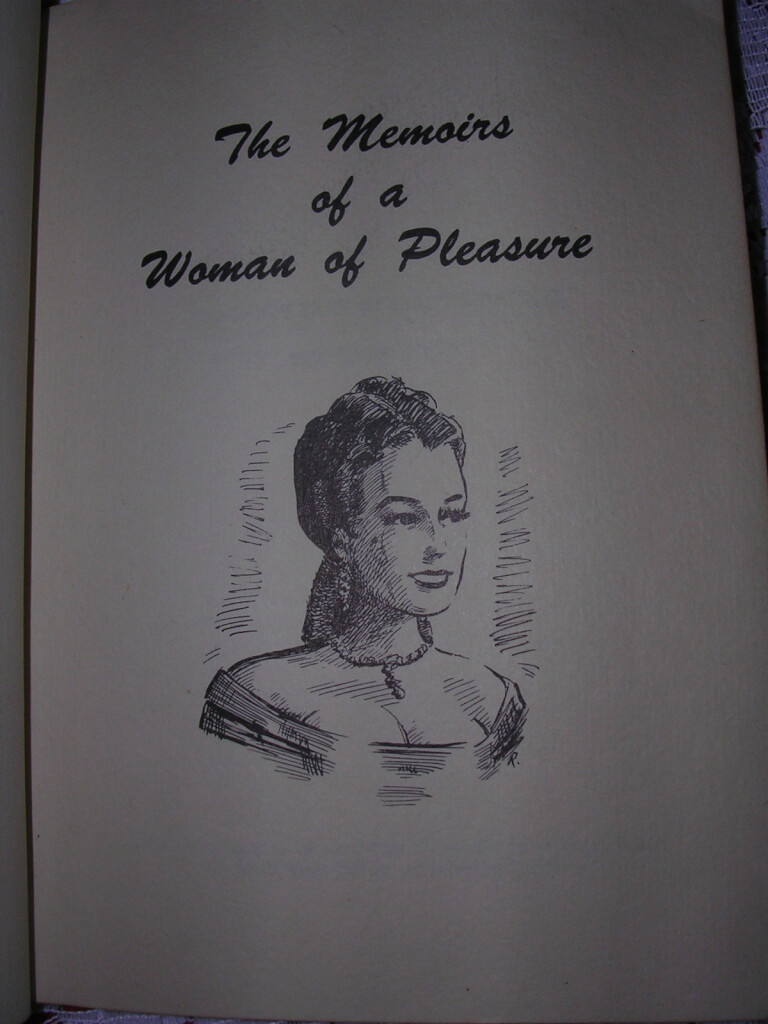
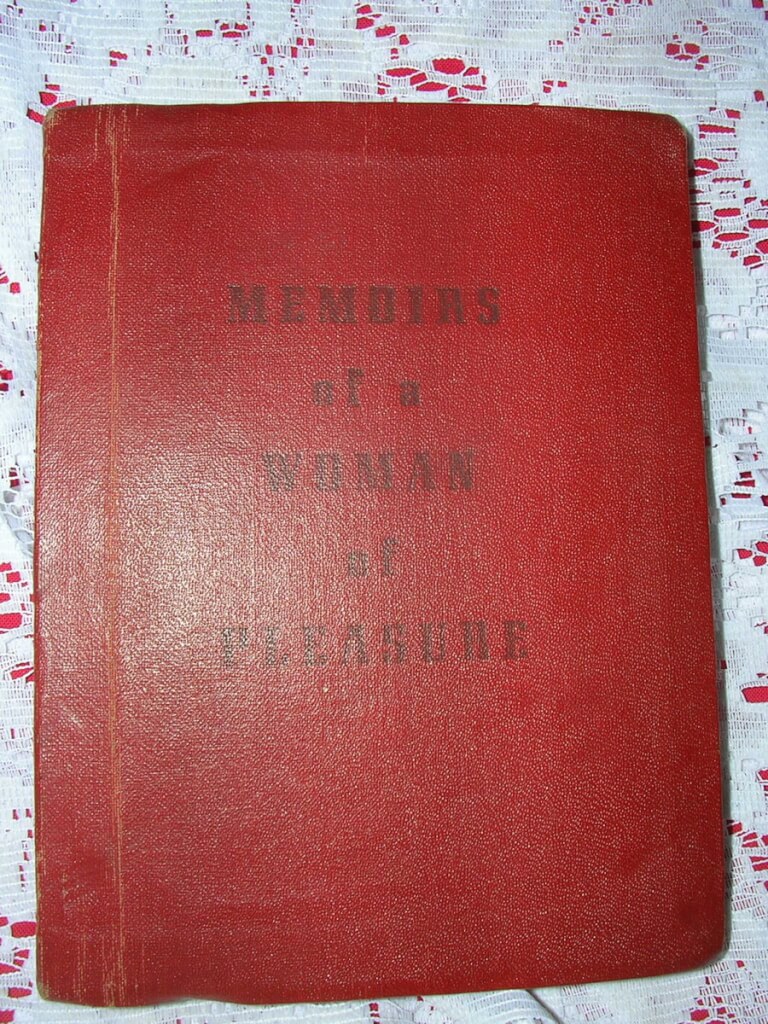 The Memoirs of a Woman of Pleasure, John Cleland (no author given) (Rare Book Co., 1949 "privately printed and a limited edition") 6 1/8" X 4 5/8", unpaginated, red limp cloth binding, illustrations by Ron Hart Written while the author was in debtor's prison in London and first published in 1749, Fanny Hill is considered the first original English prose pornography, and the first pornography to use the form of the novel. One of the most prosecuted and banned books in history, it has become a synonym for obscenity. This copy of the book only slightly resembles the original (they also neglected to name Cleland as the author). I believe this to be a "cleaned-up" version of the story. To the best of my knowledge, all eroticism has been purged. It was published by the Rare Book Company which was the publishing house for the Christian Scientists! I cannot find any mention of this little book anywhere else.
The Memoirs of a Woman of Pleasure, John Cleland (no author given) (Rare Book Co., 1949 "privately printed and a limited edition") 6 1/8" X 4 5/8", unpaginated, red limp cloth binding, illustrations by Ron Hart Written while the author was in debtor's prison in London and first published in 1749, Fanny Hill is considered the first original English prose pornography, and the first pornography to use the form of the novel. One of the most prosecuted and banned books in history, it has become a synonym for obscenity. This copy of the book only slightly resembles the original (they also neglected to name Cleland as the author). I believe this to be a "cleaned-up" version of the story. To the best of my knowledge, all eroticism has been purged. It was published by the Rare Book Company which was the publishing house for the Christian Scientists! I cannot find any mention of this little book anywhere else. -
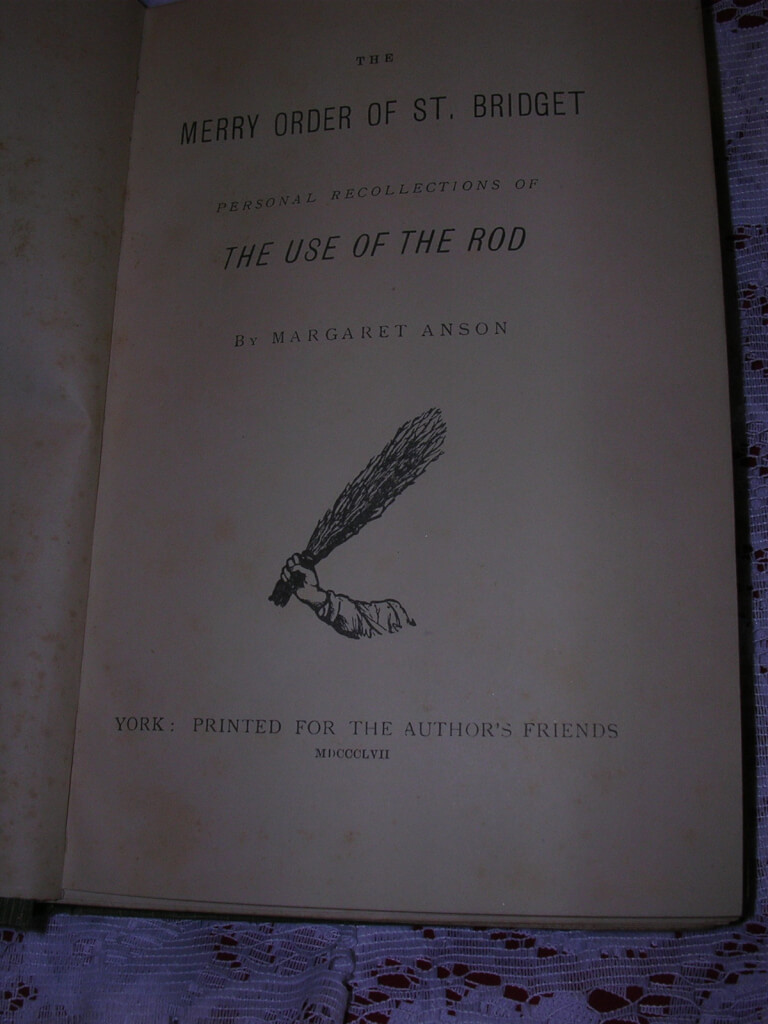
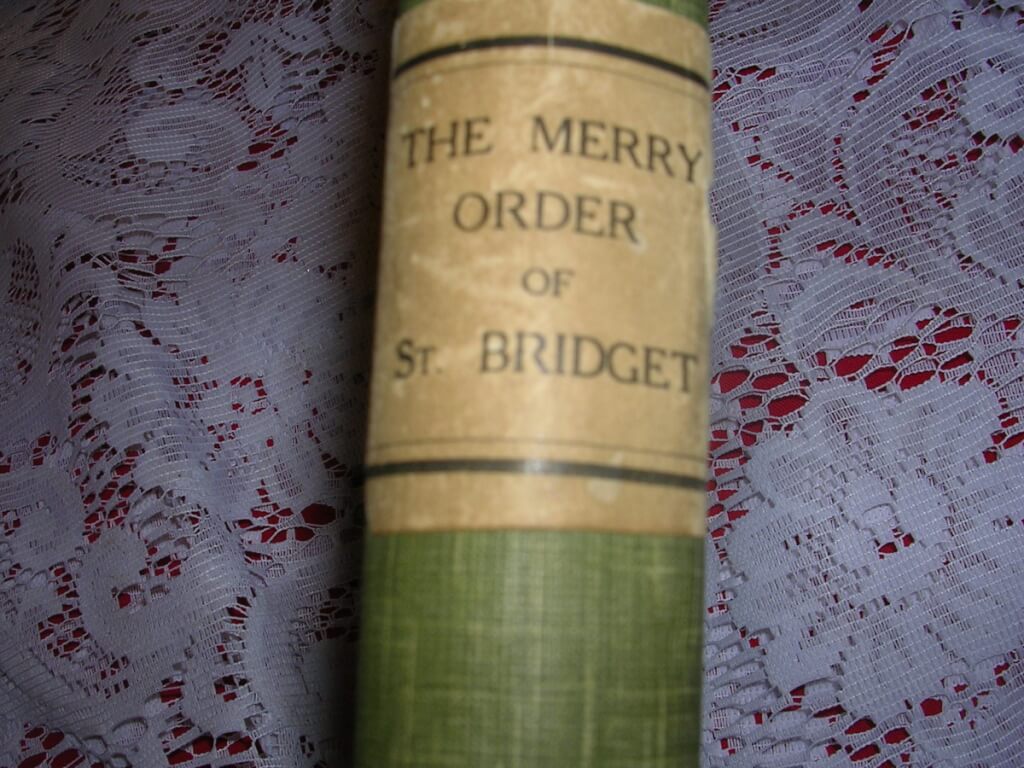 The Merry Order of St. Bridget, Margaret Anson (James Glass Bertram) (Printed for the Author's Friends, np, York, 1857 [fascimile copy of the 1868 edition c. 1930]) 7 7/8" X 5 1/4", 237pp, hardbound textured green cloth boards, paper lable on spine, deckle edges, corners and top/botton of spine bumped, binding loose but intact Bertram was apprenticed to Tait's Edinburgh Magazine and became managing clerk, before joining a company of strolling players. He returned to Edinburgh and set up as a bookseller and newsagent. In 1855 he was appointed the editor of the North Briton and in 1872 of the Glasgow News, leaving to become a freelance journalist two years later. He published "flagellation" pornography under the names "Revd William Cooper" and "Margaret Anson". In this graphic unveiling of 19th-century sexual adventures, Margaret Anson, a submissive handmaiden to the notorious Marquise St. Val_ry, describes the orgies at the Chateau de Floris, where the elite women of Paris submit to the subjugations and exotic indignities of the flesh that trigger ecstatic sensations. "Do you remember how we used to indulge in whipping on the sly, when Madame thought we were in bed? That was a very untutored way of proceeding. I have learned better since, and I can tell you that the passion for the rod is one which grows." 237 pp.
The Merry Order of St. Bridget, Margaret Anson (James Glass Bertram) (Printed for the Author's Friends, np, York, 1857 [fascimile copy of the 1868 edition c. 1930]) 7 7/8" X 5 1/4", 237pp, hardbound textured green cloth boards, paper lable on spine, deckle edges, corners and top/botton of spine bumped, binding loose but intact Bertram was apprenticed to Tait's Edinburgh Magazine and became managing clerk, before joining a company of strolling players. He returned to Edinburgh and set up as a bookseller and newsagent. In 1855 he was appointed the editor of the North Briton and in 1872 of the Glasgow News, leaving to become a freelance journalist two years later. He published "flagellation" pornography under the names "Revd William Cooper" and "Margaret Anson". In this graphic unveiling of 19th-century sexual adventures, Margaret Anson, a submissive handmaiden to the notorious Marquise St. Val_ry, describes the orgies at the Chateau de Floris, where the elite women of Paris submit to the subjugations and exotic indignities of the flesh that trigger ecstatic sensations. "Do you remember how we used to indulge in whipping on the sly, when Madame thought we were in bed? That was a very untutored way of proceeding. I have learned better since, and I can tell you that the passion for the rod is one which grows." 237 pp.














